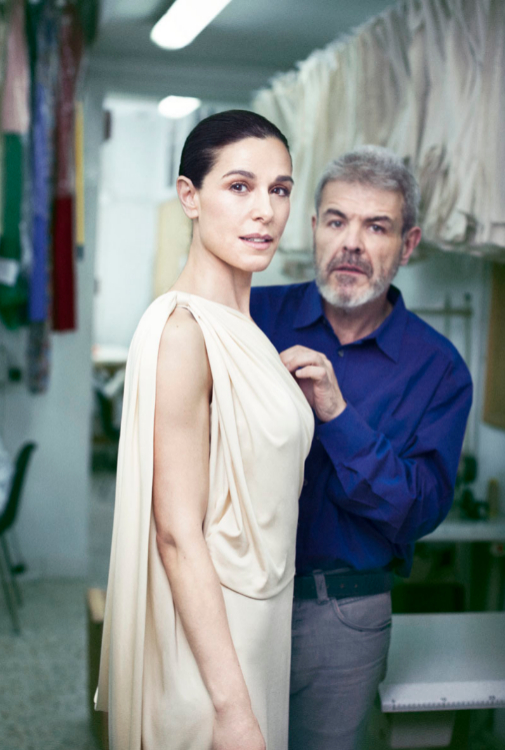- Lorenzo Caprile: "If this lasts much longer, I will ask permission to set up a campaign workshop"
He is famous for dressing Anne Igartiburu every December 31 to give the chimes on television, also for being a jury for the 'Masters of Sewing' program and for signing the wedding dresses of many Spanish celebrities. He was extremely successful when he made for Queen Letizia a spectacular red ball gown with which he fell in love with European royalty at the wedding of Frederick and Mary of Denmark. But what few people know is that Lorenzo Caprile treasures a huge collection of antique clothing and accessories made up of around 10,000 pieces from different origins. Today she wanted to show part of this wardrobe in Yo Dona, through the presenter and good friend of hers Raquel Sánchez Silva, who poses with some of the most valuable creations.
I DONATE When did you start collecting dresses and accessories? Lorenzo Caprile He was very small, he was 13 or 14 years old and he always went shopping with my mother. How many pieces do you treasure? I think about 10,000, because I have been acquiring many shoes and belts. Bags I keep less. Do you also advise other collectors? No, what is it, I prefer to continue with my workshop, to mine. This is just a hobby. How did you select the models that Raquel Sánchez Silva wears in these photos? I mentioned the names of the creators that I would like them to be because of their importance in fashion history: Pedro Rodríguez, Elio Berhanyer and Pertegaz , but it was Isabel Moralejo, Fashion director of the magazine, who made this exquisite selection. I was delighted that he chose the Manuel Piña trench coat , because it is a great reference for those of my generation. I am also very happy to show Felisa Irigoyen's dress. She was Balenciaga's shop manager and when it closed, she settled on her own. We had a very close relationship and when he left his atelier he gave me many costumes. Of all the ones you have, which one is your favorite? I don't have one in particular, they all seem wonderful to me. But I remember one that I bought at a bargain price. Every month they put everything in the stores of the Human Foundation for a euro and you have to dig a lot. On one of those occasions, I found a shirtmaker from the 70s by a French-American creator named Pauline Trigère, and she gave me a high rush. To place the dressmaker, in the movie 'Breakfast with diamonds' Givenchy dressed Audrey Hepburn and Pauline Trigère did it with Patricia Neal (the writer's lover played by George Peppard). I recommend his biography because it has a fascinating story. He came to New York, like many others, fleeing from World War II and is a fundamental figure in the American fashion of the 60s and 70s. I was very lucky, because when I studied there, in my youth, I had the opportunity to meet her. Why Raquel Sánchez Silva as a model for these suits? Because in addition to having a great body, she is very female and I like that. I prefer her to a model that looks like girls. Realize that those of my generation saw real women parading, like Linda Evangelista, Cindy Crawford ... I am happy with the result. This collection and your way of working show that it is normal for you to reuse clothes. Do you think the industry will become more sustainable? Controlling all the processes and materials involved in the manufacture of a dress, from the fabric to the buttons or zippers, is very complicated, practically impossible to achieve one hundred percent. Today's ecological discourse seems very nice to me, but also utopian. Also, the consumer is used to buying a lot. I do not know if we will be able to reverse it. Your work philosophy has always been to consume less and better. Yes, because I do custom fashion. Nor do I have the means or the infrastructure to set up a production chain. I'm not worth it. Have you lent pieces from your personal archive for some women to see? Yes, many times, I like that they are used, that's why I have given them to several friends: Raquel Sánchez Silva, for example, and Julia Martínez, head of Styling from Telva, too. With so much jewel, haven't you thought about showing them in an exhibition? Yes, from 'Masters of Sewing' they are helping me to look for financing, although at the moment it is difficult to find an ideal place to do it. The Costume Museum, for example, would be perfect, but it is under construction and it is a shame, because in addition to being the right location, I am very in tune with its director, Helena López del Hierro.This is how Raquel Sánchez Silva looks some of the pieces that Lorenzo Caprile treasures in his collection
According to the criteria of The Trust Project
Know more- fashion
InterviewRocío Crusset: '' There is a before and after of #MeToo ''
ModaRaquel Sánchez Silva: '' The level of 'Masters of sewing' has risen a lot ''
Social networksThe sports with the face of Hitler that spark controversy

